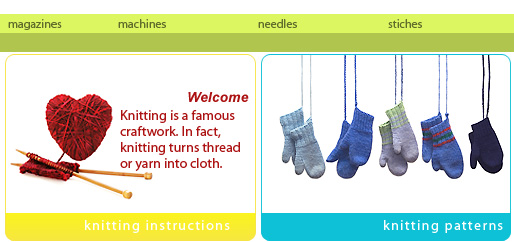Knitting Yarn
Yarn is the material used for knitting. Yarn is sold as ball or skein,s or it may be also in spools or cones for hand knitting. Yarn-band has a label around the balls or skeins, which describes the length, weight, and fiber content and dye lot. It also suggests the needle size and also the washing instructions. The common practice for knitters is to save the yarn band for future reference, if they might need any additional balls. Knitter uses the yarn from a single dye lot. If the skeins are used from a different dye lot even if the color is same, it produces a slightly different stripe, which is visible when it is knitted together. If the knitter has the dye lot information, they can buy the same yarn to complete the fabric. Thicker knitting needles are used for thicker yarns and thin needles are sufficient for thin yarns. When thicker yarn is used, the stitches are fewer and it takes less time to knit the piece. Bold patterns and motifs are produced with thicker yarns and the finer patterns are made with thin yarns. The thickness of the yarn is categorized as superfine, fine; light bulky, superbulky and medium.
The knitters usually transform a hank into a ball. The yarn is emerged from the center of the ball and this prevents the yarn from tangling. This can be either done by hand or using a device called ballwinder. Some knitters put this ball in a close jar and pull out the yarn through a small hole, made in the lid of the jar. The elasticity, loft, softness, durability, fuzziness, tendency to twist, weight, color, smoothness, wash ability are factors taken into account before using the yarn for knitting. The general factors that affect the hand knitting, are elasticity and tendency to twist. Irregularities are more elasticity and it is sometimes difficult to knit highly twisted yarns. Stitch definition plays an important role in knitting. To show off the stitch patterns, smooth and spun yarns are used. Fuzzy yarns have a very poor stitch definition.
Knitting is mostly done with the yarns that are made by spinning fibers. Z-twist or S- twist yarn direction does either the twisting of fiber. The yarn becomes smoother, if the fibers are combed and yarn becomes fuzzier if the fibers are not combed. The fibers can be either continuous filament fibers or staples.
The different spun fibers are animal fibers, plant fibers and synthetic fibers. Generally the long hairs of animals such as sheep, goat, rabbit, and yak are used for fibers. Plants like cotton, flax, bamboo, jute, raffia, and yucca are used for fibers. Polyesters such as nylon and Dacron are the common synthetic fibers. Yarns may be dyed for one color or for variety of colors. Dyeing is done by hand or by industrially. Natural dyes are often used for dying.
Huge varieties of yarns are sold in the market. Knitters can also have their own collection, which is called stash.
